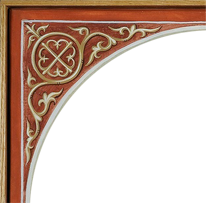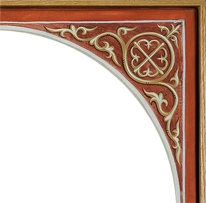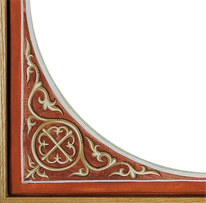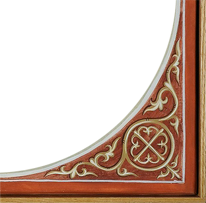Are non-Orthodox visitors welcome?
Yes! The Church of Jesus Christ is a house of prayer for all people, and we welcome anyone who is interested in worshiping the Holy Trinity with us. Most of our congregation was not born into the Orthodox Church and faith. We began like many of you - with a desire to find out what the real "early Church" was, and what it believed and practiced. Many of us came from Evangelical, Reformed, Anglican, Charismatic, Roman Catholic and non-denominational Christian backgrounds. Others have come from eastern religions or through new age interests. You will find a wide diversity of faith traditions, races, age groups and ethnic groups represented at our parish.
So don’t be afraid to ask questions about what we do and why (at the appropriate time, of course!)! We offer books and pamphlets that can help answer a variety of questions. Subjects include Christian church history, theology, catechism, Orthodox spirituality, inspiration, prayer, the lives of the Saints, and stories about others who have journeyed to the Orthodox Faith.
You enter the church through the narthex, where you will find pamphlets and printed service texts of the Divine Liturgy available in the Narthex (the entryway). As you enter the church Sanctuary (nave), the sacred space where the congregation worships, feel free to find a place anywhere. Our normal Sunday service is the Divine Liturgy of Saint John Chrysostom. You may follow the service text, or, if you prefer, simply close your eyes and enter into the Church’s beautiful worship of God.
Following the Sunday Divine Liturgy, you are invited to join us in the fellowship hall for Coffee Hour which is a good time to get to know our parish members.
What is Orthodox worship like?
Unlike any other Christian church you will visit! We believe that when we pray in Church, we are mysteriously entering into the never-ending worship that is happening in heaven. We join our voices to those of the angels, the saints, and all Orthodox Christians everywhere. We are spiritually taken into Heaven, into the very throne room of God.
Our worship engages all five senses. There are things to see, hear, touch, smell, and taste. The services are mostly sung or chanted, and consist largely of Biblical quotes and references, along with elements that have been present since the very early days of the Christian Church.
What if I get lost?
The service books are helpful, but only up to a point. Orthodox divine services are assembled from different resources according to the Church calendar and ancient traditions; service books cannot fully accommodate this reality. For your first few visits, you may consider simply listening and watching the service and not worrying about following along. Do your best to take it all in. When you have a feel for the services, the books will be more helpful.
How long are the services?
Great Vespers (Evening prayers) on Saturday nights at 6:00 PM is usually 30-45 minutes in length. Orthros (Morning prayers) on Sunday mornings begins at 8:20 AM., followed by the Divine Liturgy which begins at 9:30 AM. and runs about two hours.
We think that when you have participated in an Orthodox service you will feel like – as one visitor put it – “you have truly worshipped the living God!”
For specific service times, please consult our calendar.
Is there a dress code?
The general rule for men and women is to dress appropriately, modestly and respectfully, as before the living God. Visitors wear everything from casual clothes to suits, long dresses to skirts, casual shirts to shirts with ties. We ask, however, that you not wear shorts, mini-skirts, tank tops, low-cut or strapless dresses (unless covered by a sweater, etc.). You will see some Orthodox women wearing head coverings, but this is not required. Men are asked not to wear head coverings (baseball caps, etc.) in the nave.
Is childcare provided?
Each parent is responsible to take care of their child. We encourage children to be present in Church for the services. This participation is part of a child’s spiritual formation. Children can be restless, and as long as they move around quietly with you it is no problem. However, if your baby or child gets fussy, talkative, or has a melt-down, please take him or her out of the nave until he or she is ready to return quietly.
Standing or sitting?
The traditional posture for prayer and worship in the Orthodox Church is to stand, as before the King of the universe! In many Orthodox churches there are typically no pews in the churches. When you visit us you will find pews and chairs, so you are free to sit. However, it is appropriate to stand during the Gospel reading, the Little and Great Entrances, the distribution of Holy Communion, when the priest gives a blessing, and at the Dismissal. Just follow the congregation!
Lighting candles?
Lighting candles is an important part of Orthodox worship and piety. We light candles as we pray, making an offering to accompany our prayers. Orthodox typically light candles when coming into the church, but there are times when candles should not be lit. Candles should not be lit during the Epistle or Gospel readings, during the Little Entrance, and during the sermon. By the way, you do not have to be an Orthodox Christian to light a candle and pray in an Orthodox church!
Can non-Orthodox receive the Holy Eucharist?
Because the Eucharist is one of the Sacred Mysteries of the Orthodox Church, only baptized and chrismated Orthodox Christians who have prepared themselves through recent confession, prayer and fasting may receive communion. This is the ancient tradition of the Holy Church for the 2,000 years of its history. The Orthodox Church understands the Holy Eucharist as a mystery of the real presence of Christ in the Eucharist, not simply as a memorial, or merely in a spiritual sense, as many other non-Orthodox Christians do. We ask that you respect the ancient, apostolic tradition regarding communion, rather join us in receiving the ‘antidoron’ (blessed bread) at the end of the Divine Liturgy.
What are all the pictures?
Orthodox Churches of all cultures are adorned with these images called Icons. Icons have been a part of Christian worship since the first century. They depict the life and acts of Jesus Christ and the saints, the heros of the Faith, who are alive in heaven with God, yet still present with us. You will see people kiss and bow to venerate the icons as a sign of respect. While Jesus Christ, the saints, and the angels are all around us (Hebrews 12:1), we cannot see them. The icons are a way for us to honor them.
You do not have to venerate the icons if you are uncomfortable doing so. If you do, out of respect for others please be sure your lips are clean (no lipstick, please).
What is Orthodox worship music like?
An Orthodox service is chanted and sung by readers and the choir. Traditionally, Orthodox do not use instruments. The style of music is mostly very traditional Byzantine-sounding chant. The music is solemn, prayerful and intended to lead the faithful to worship the living God.



